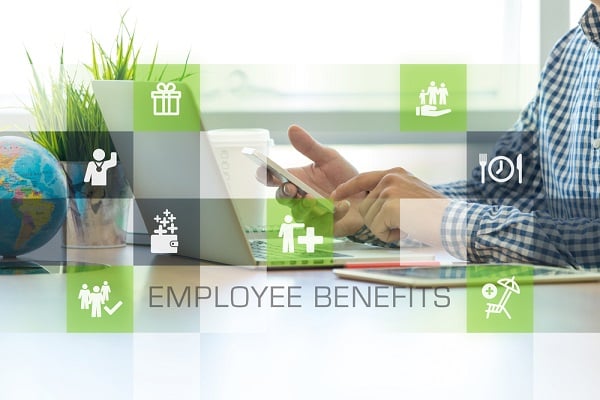 As brokers, you have the opportunity to help employers design benefits programs that provide the flexibility their employees need to better manage all the moving parts in their lives.
As brokers, you have the opportunity to help employers design benefits programs that provide the flexibility their employees need to better manage all the moving parts in their lives.
We've surpassed the two-year milestone of the period when the way we live and the way we work changed forever. Yet even today, employees are still struggling to successfully meld their work and personal lives. It can be an unsettling task, resulting in increased stress and decreased job satisfaction and productivity.
Maintaining the "perfect" balance—where we try to keep our work and personal lives separate, yet equal—can be an unrealistic expectation. It has always been challenging to set hard and fast boundaries between work and home life, but with the emergence of remote and hybrid work environments and "always on" technologies, that line has blurred even more. Some have argued that embracing a mindset of work/life integration where there's more fluidity between these two demanding worlds may now be more attainable.
Recommended For You
Whichever philosophy works best for your clients' workforces, the key will be added flexibility. As brokers, you have the opportunity to help employers design benefits programs that provide the flexibility their employees need to better manage all the moving parts in their lives.
Working from anywhere works
For some, working remotely has largely enabled employees to find more balance—and they're anxious to maintain it. In a 2021 State of Remote Work survey, almost 98% of respondents indicated they would like to work remotely at least some of the time for the rest of their career. Not surprising.
I've worked as a remote employee for more than 10 years now, and I suspect that in your role, you also adapted quickly to life as a remote employee, successfully conducting meetings and building business relationships with clients and partners via video conferencing. While we've all had to make some adjustments, in many ways it's allowed us to be more efficient with our time and flexible with our schedules.
Employees aren't the only ones who can benefit from this enlightened view of traditional work/life balance. Employers who are committed to providing more flexibility and support for their employees can save on costs, experience fewer cases of absenteeism and enjoy a more loyal and productive workforce.
Plus, offering benefits that boost flexibility and support is a great tool for recruiting and retaining high-value employees, especially in a very mobile and dynamic job market.
Introducing the fluid workday
Employers are at an inflection point as they consider what their employees' return to the office looks like in the context of the larger phenomenon of employees reinventing how they work. I spoke with Lisa Wolf, director of people and culture at ARAG, about how the company has addressed this emerging need for work/life integration. She's not only leading this charge, she's also living the reality as a busy mom of four children (three of whom are triplets!).
"My goal, even before the pandemic hit, has always been for employees to be able to work from wherever they are. As their employer, we have to give them the tools, programs and processes to be able to support that," Wolf says. "Because we know that these days, people have lots of demands in their personal lives, and they are looking for a job that integrates with that and allows them to do what they need to do."
Wolf adds, "With this increased flexibility, it's not uncommon for an employee working from home to knock out an hour or two of work before their children wake up, then run them to school and log back on for meetings the rest of the morning. That afternoon, they may take a parent to a doctor's appointment but then log on again later to catch up on some of the day's work.
"It isn't so much working 9-to-5 anymore; it's a more fluid workday, as career and personal commitments blend together throughout the entire day."
The impact on women in the workforce
But when the pendulum swings too far in either direction, it can put a strain on mental health, Wolf says.
Women shoulder a great deal of those personal outside commitments. According to a 2020 Women in the Workplace Study by McKinsey & Lean In, 1 in 4 women have considered downshifting their career or leaving the workforce entirely because of incidents of burnout, increased demands at home, homeschooling and caregiving. In fact, over 66% of caregivers are female, and women also provide the majority of informal care to spouses, parents, etc. The study also revealed that lack of flexibility at work was a top reason women left the workforce.
"You want to have a healthy mix between work and your outside obligations," Wolf says. "The key is being fair to your organization and doing what you need to do to get the job done; but it can't be done at the sacrifice of your own health."
In 2021, almost twice as many women joined the workforce as men, and more organizations are now providing women-friendly/family-friendly benefits to help them remain a productive and less stressed part of the workforce. Those benefits include offerings such as flexible work options, geoneutral pay and caregiving support, as well as adoption and fertility assistance.
Talk to clients about flexible benefits
As you interact with clients, consider what benefits they can offer that will serve their employees best as they continue integrating their work and personal lives. Here are some different ways to get that conversation rolling:
Listen and empathize.
Today's workforce is more diverse than ever, with multiple generations, different lifestyles to consider, and unique challenges at home. Recommend benefits and programs that offer their employees more support and act as a conduit for information and resources. Tap into and promote employee resource groups (ERGs) that provide peer support and also offer valuable feedback on employees' needs.
Take Hershey, for example. Its series of SmartFlex benefits includes FamilyFlex, enabling employees to carve out time to care for loved ones. Its HSY Care Connect app, a collaboration between HR and a women's business resource group, provides childcare, transportation, tutoring and eldercare resources.
Similarly, Disney offers its workforce a range of family care resources to "help maintain balance while caring for loved ones," including backup care for children, elders, and even pets, as well as homework help for employees' kids.
Re-evaluate time off policies.
Time off is a hot commodity for workers who are stretched thin by childcare needs and caregiving commitments. More companies now offer team members additional paid time off to care for a loved one. Benefits like these are more prevalent in today's workforce, as nearly 4 in 10 workers are employed at a firm that started offering or expanded paid leave benefits since the COVID-19 pandemic began.
Promote ways to use existing employee benefits.
Ensure employees take advantage of all the provisions and options your clients' benefit plans provide. This could include promoting previously untapped resources provided by an EAP, ensuring that mental health coverage is a robust part of the health care plan, and offering programs that promote mindfulness and wellbeing. Employee demand for these benefits is palpable, as nearly half (46%) of companies with more than 5,000 employees saw a marked increase in the number of workers using mental health services since the pandemic started.
Make it as easy as possible to access these benefits.
Many employees got a crash course in turning to technology to do their work during the pandemic and are no longer strangers to using online tools and services. They want that same level of ease and familiarity when accessing their benefits, whether it's an online chat feature with a mental health specialist or downloading an app to view their medical coverage.
From June to December last year, 17% of our legal insurance plan members started a new case themselves online versus calling in and speaking with a customer care specialist. And consider this: 86% of our network attorneys are now completely equipped to deliver a virtual experience for clients.
It's time to gauge how you can help your clients design a benefits portfolio with the flexibility to support employees' ongoing quests to maintain equilibrium in their work and home lives. And keep this thought from Wolf in mind as she reflects on what she's learned in the past few years:
"Collectively, what I've heard from our employees is, 'I want you to trust me to do my job in this new work environment, and I want the freedom as well.' At the end of the day, we have to shift our mindset and offer added flexibility or we are not going to be able to attract and retain talent in a competitive market."
Dennis Healy is a member of the ARAG® executive team. Dennis is a passionate advocate for legal insurance because he has seen firsthand how it helps people receive the protection and legal help they need. He has nearly 30 years of insurance industry experience, with a primary focus on the sale of group voluntary benefit products to employer groups of all sizes through the brokers and consultant community.
© Touchpoint Markets, All Rights Reserved. Request academic re-use from www.copyright.com. All other uses, submit a request to [email protected]. For more inforrmation visit Asset & Logo Licensing.






